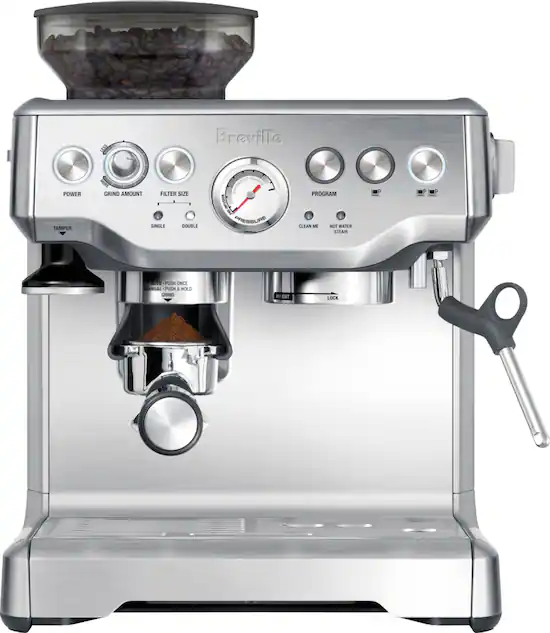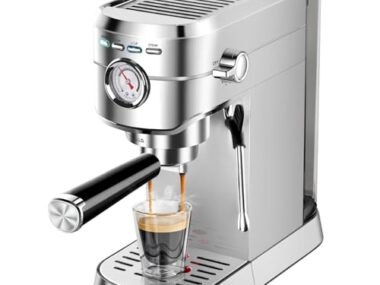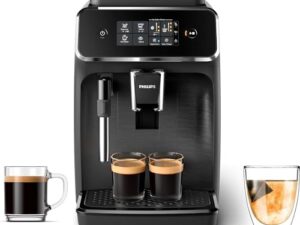Finding the best espresso machine involves considering features and budget. It’s about matching your needs with the right machine.
Whether you crave a rich, creamy cappuccino or a bold espresso shot, choosing the best espresso machine can elevate your coffee experience at home. But the process can be overwhelming with so many options available. From manual to fully automated machines, each type offers unique benefits.
Determining the right fit requires understanding what you value most in your coffee-making ritual. Do you prefer a quick brew or enjoy the art of crafting each cup? This guide will help you navigate the choices, focusing on ease of use, quality, and durability. So, let’s explore how to make the perfect pick for your coffee corner.
Types Of Espresso Machines
Choosing the best espresso machine can be overwhelming. There are various types of espresso machines, each with unique features. Understanding these types can help you make the right choice. Here are the main types of espresso machines you should consider.
Manual Machines
Manual espresso machines, also known as lever machines, offer a traditional brewing method. These machines require you to manually control the pressure and timing. This can be both rewarding and challenging.
Advantages:
- Complete control over the brewing process.
- Can produce high-quality espresso.
- Elegant design.
Disadvantages:
- Requires skill and practice.
- Time-consuming.
- Not suitable for beginners.
Who should buy: Coffee enthusiasts who enjoy hands-on brewing.
Semi-automatic Machines
Semi-automatic espresso machines offer a balance between manual control and automation. You can adjust the grind size and brewing time, but the machine handles the water pressure.
Advantages:
- More control than automatic machines.
- Easier to use than manual machines.
- Consistent results.
Disadvantages:
- Requires some skill.
- More expensive than manual machines.
- Can be bulky.
Who should buy: Users who want control over their espresso but prefer some automation.
Fully Automatic Machines
Fully automatic espresso machines take convenience to the next level. These machines control the entire brewing process, from grinding the beans to brewing the espresso.
Advantages:
- Easy to use.
- Consistent results.
- Suitable for beginners.
Disadvantages:
- Less control over brewing.
- More expensive.
- Can be bulky.
Who should buy: Users who want a hassle-free brewing experience.
Capsule Machines
Capsule espresso machines use pre-packaged capsules. These machines are convenient and easy to use. They are perfect for those who want a quick espresso without the fuss.
Advantages:
- Very easy to use.
- Quick brewing process.
- Compact and portable.
Disadvantages:
- Limited control over brewing.
- Ongoing cost of capsules.
- Less variety in coffee flavors.
Who should buy: Users who value convenience and speed.

Credit: www.bestbuy.com
Key Features To Consider
Buying the best espresso machine can feel overwhelming with so many options. Understanding key features helps make an informed choice. Each feature influences the quality, efficiency, and ease of use of the machine. Let’s explore the essential features to consider when buying an espresso machine.
Boiler Type
The boiler is the heart of an espresso machine. It heats the water to the perfect temperature. There are several types of boilers to consider:
- Single Boiler: Suitable for home use. Ideal for making one type of drink at a time.
- Dual Boiler: Lets you brew espresso and steam milk simultaneously. Great for making multiple drinks quickly.
- Heat Exchange Boiler: Offers similar benefits to dual boilers. Often found in mid-range machines.
Choosing the right boiler affects the machine’s performance and your coffee-making experience. Single boilers are more affordable but take longer to make multiple drinks. Dual boilers provide convenience but are usually more expensive.
Consider how often you make coffee and your budget. This will help you decide which boiler type meets your needs.
Pump Pressure
Pump pressure is critical for extracting flavors from coffee grounds. Most experts agree that 9 bars of pressure is ideal for espresso.
Here is a quick guide:
| Pressure | Result |
|---|---|
| Below 9 bars | Under-extracted coffee. Weak flavor. |
| 9 bars | Perfect extraction. Balanced taste. |
| Above 9 bars | Over-extracted coffee. Bitter taste. |
Ensure the machine you choose offers consistent pressure. Machines with adjustable pressure allow more control over brewing. This feature is crucial for those who enjoy experimenting with coffee flavors.
Size And Capacity
Size and capacity are practical considerations. They affect where you can place the machine and how much coffee it can produce.
Think about:
- Kitchen Space: Measure your counter space before buying. Avoid bulky machines if space is limited.
- Water Tank Capacity: Larger tanks mean less frequent refills. Ideal for families or frequent coffee drinkers.
- Bean Hopper Size: Larger hoppers hold more beans. Perfect for making many cups in one go.
Consider your lifestyle and how often you entertain guests. A compact machine suits small kitchens, while a larger one is better for coffee enthusiasts.
Ease Of Use
An easy-to-use espresso machine saves time and effort. Look for features that simplify the brewing process.
Here are some to consider:
- Automatic Features: Machines with automatic settings ensure consistency. Perfect for beginners.
- Cleaning and Maintenance: Removable parts make cleaning easier. Look for machines with self-cleaning functions.
- User Interface: Simple controls and clear displays enhance usability. Touchscreens are intuitive and modern.
A machine that’s easy to use encourages regular coffee-making. It should fit seamlessly into your daily routine. Prioritize these features to enjoy hassle-free coffee every day.
Budgeting For Your Machine
Buying the best espresso machine requires careful planning. One key step is budgeting for your machine. Understanding your budget helps you find an espresso machine that matches your needs without overspending. Whether you are a beginner or a coffee enthusiast, knowing your budget can guide you toward the right choice. Let’s explore different price ranges to help you decide.
Entry-level Options
Entry-level espresso machines are perfect for those new to coffee making. These machines are affordable and easy to use. They offer basic features that allow you to brew a decent cup of espresso without complicated settings.
Here are some common features found in entry-level options:
- Simple controls
- Basic pressure systems
- Manual frothing wand
While these machines might lack advanced features, they provide good value for money. They are ideal for those who enjoy a straightforward coffee-making process. Many models are available under $200, making them accessible for most budgets. A simple table below showcases typical costs:
| Brand | Price Range |
|---|---|
| Model A | $100 – $150 |
| Model B | $150 – $200 |
Mid-range Choices
Mid-range espresso machines offer a balance between cost and features. They cater to coffee lovers seeking more control and customization. With additional settings, these machines can brew espresso with greater precision.
Features you might find include:
- Programmable settings
- Digital displays
- Automatic milk frothing
These machines typically range from $200 to $500. They are suitable for those who want to enhance their coffee experience without spending a fortune. The table below highlights some popular mid-range options:
| Brand | Price Range |
|---|---|
| Model C | $250 – $300 |
| Model D | $350 – $450 |
High-end Models
High-end espresso machines are designed for serious coffee aficionados. These models offer advanced features and superior build quality. They allow users to craft barista-quality espresso at home.
Expect features like:
- Dual boilers
- Pressure profiling
- High-quality materials
Prices for high-end models range from $500 to several thousand dollars. They offer unparalleled precision and durability, making them perfect for those who prioritize quality. Here’s a brief look at some high-end options:
| Brand | Price Range |
|---|---|
| Model E | $600 – $1,000 |
| Model F | $1,000 – $3,000 |

Credit: www.nytimes.com
Brand Recommendations
Finding the best espresso machine can be challenging. One of the most important things to consider is the brand. Different brands offer different features, quality, and prices. Knowing which brands are reputable and which are emerging can help you make an informed decision.
Top Brands
Several brands are well-known in the espresso machine market. These brands have established a reputation for quality and reliability. Here are some top brands to consider:
- Breville: Known for user-friendly designs and high-quality machines. Breville offers a range of options from entry-level to professional-grade.
- De’Longhi: Offers a wide variety of espresso machines. Known for their durability and innovative features.
- Jura: Specializes in automatic espresso machines. Jura machines are known for their high quality and consistent performance.
- Rancilio: Known for their commercial-grade machines. Rancilio offers robust and durable options suitable for home use as well.
- Nespresso: Offers convenient pod-based espresso machines. Nespresso is known for ease of use and consistent results.
Emerging Brands
While established brands are a safe bet, several emerging brands are making waves in the espresso machine market. These brands offer innovative features and competitive prices. Some emerging brands to watch are:
- Gaggia: An Italian brand gaining popularity for its high-quality, affordable machines. Gaggia offers both manual and automatic options.
- Ascaso: Known for their stylish and modern designs. Ascaso machines are becoming popular for their performance and aesthetics.
- Flair: Specializes in manual espresso makers. Flair machines are portable and user-friendly, making them a great choice for espresso enthusiasts.
- Wacaco: Offers portable espresso machines. Wacaco is known for innovation and convenience.
- 1Zpresso: Focuses on manual grinders and espresso makers. 1Zpresso is gaining a reputation for quality and affordability.
Local Vs. International Brands
When choosing an espresso machine, consider whether you prefer local or international brands. Both have their advantages:
| Aspect | Local Brands | International Brands |
|---|---|---|
| Availability | Readily available in local stores | May require online purchase |
| Customer Support | Easy to access and communicate | May have better global support |
| Variety | Limited options | Wide range of products |
| Price | Can be more affordable | Varies by brand and model |
Local brands often offer better customer support and easier access to repairs. They might have fewer options but can be more affordable. International brands usually offer a wider variety of products and may have better global support networks. They might be more expensive but often come with advanced features and higher quality.
Customer Reviews
Buying the best espresso machine can be a daunting task. With so many brands and models, how do you choose? Customer reviews are a great way to learn about the real-life performance of espresso machines. They provide insights into the machine’s functionality, durability, and overall value. Reviews can help you avoid costly mistakes and find a machine that fits your needs and budget.
What To Look For
When reading customer reviews, focus on specific features and experiences that matter to you. Here are some key aspects to consider:
- Performance: Does the machine consistently produce good espresso? Look for comments on taste and crema.
- Durability: Is the machine built to last? Check for mentions of longevity and common issues.
- Ease of Use: Are the controls user-friendly? Consider reviews that discuss the learning curve.
- Cleaning and Maintenance: How easy is it to clean? Look for notes on maintenance frequency and difficulty.
- Customer Service: How responsive is the company? Read about experiences with support and warranty claims.
These elements will give you a clearer picture of what to expect from the espresso machine.
Where To Find Reviews
Finding reliable customer reviews is crucial. Here are some trusted sources:
- Online Retailers: Websites like Amazon and Best Buy offer user reviews. They often include detailed feedback and ratings.
- Specialized Coffee Forums: Join forums like CoffeeGeek or Home-Barista. Members share honest reviews and expert opinions.
- Social Media: Follow coffee enthusiasts on platforms like Instagram and Twitter. They often post reviews and recommendations.
- Manufacturer Websites: Check the official sites for testimonials and user feedback. But take them with a grain of salt.
Using a combination of these sources can help you gather comprehensive insights.
Interpreting Ratings
Understanding ratings is essential to making an informed decision. Here’s how to decode them:
- Overall Score: Pay attention to the average rating. It provides a quick snapshot of customer satisfaction.
- Number of Reviews: A high rating with only a few reviews might not be reliable. Look for products with numerous reviews.
- Consistency: Read multiple reviews to see if the experiences align. Consistent feedback is usually more credible.
- Negative Reviews: Focus on common complaints. They might indicate potential deal-breakers.
- Detailed Feedback: Reviews with specific details are more helpful. They offer a deeper understanding of the product.
Carefully interpreting these ratings can guide you to the best choice for your needs.
Where To Buy
Buying the best espresso machine can be a delightful journey. Understanding where to purchase is key. The right place can impact your buying experience and the quality of the machine. Whether you prefer the convenience of online shopping or the hands-on experience of visiting a store, knowing your options will help you make an informed choice. Let’s explore where you can buy the perfect espresso machine.
Online Retailers
Shopping online offers a world of possibilities. You can compare prices, read reviews, and explore a wide range of models. Some popular online retailers include:
- Amazon: Known for its vast selection and customer reviews. Look for machines with high ratings.
- eBay: Great for both new and used machines. Check seller ratings for reliability.
- Best Buy: Offers detailed product descriptions and customer service.
Online shopping provides convenience and variety. Here’s a simple comparison of some features:
| Retailer | Selection | Price Range | Return Policy |
|---|---|---|---|
| Amazon | Extensive | $100-$3000 | 30 days |
| eBay | Varied | $50-$2500 | Varies by seller |
| Best Buy | Moderate | $150-$2000 | 15 days |
Consider delivery times and shipping costs. Also, look for online discounts or bundle deals.
Local Stores
Buying from a local store offers a hands-on experience. You can see and touch the machines before buying. Some stores also provide demonstrations. Popular local options include:
- Appliance Stores: Often have knowledgeable staff who can guide your choice.
- Department Stores: May offer seasonal discounts and promotions.
- Specialty Coffee Shops: These may have high-end models and barista advice.
Local shopping allows you to ask questions directly. You can often negotiate prices or get added value services like installation. Here’s what you can expect in a local store:
- Personalized service and expert advice.
- Immediate availability; no waiting for delivery.
- Possibility to see the machine in action.
Local stores support the community and provide a personal touch to your shopping experience.
Second-hand Options
Buying second-hand can be a budget-friendly choice. You can find quality machines at a fraction of the original price. Here are some avenues to explore:
- Classified Ads: Websites like Craigslist or local bulletin boards often list used machines.
- Online Marketplaces: Sites like eBay or Facebook Marketplace have user reviews and ratings.
- Thrift Stores: Occasionally have hidden gems at bargain prices.
When buying second-hand, inspect the machine carefully. Look for signs of wear and ask about maintenance history. Here are some tips:
- Test the machine if possible.
- Check for warranty, even if partially available.
- Read reviews about the model, not just the seller.
Second-hand options are sustainable and can be a treasure hunt for coffee enthusiasts.
Maintenance Tips
Buying the best espresso machine is an exciting venture for coffee lovers. Maintaining your machine is crucial to ensure it continues to produce delicious espresso. Regular maintenance keeps your machine in peak condition and enhances its lifespan. Below are some essential maintenance tips to help you keep your espresso machine performing at its best.
Cleaning The Machine
Cleaning your espresso machine is vital. It prevents the buildup of coffee oils and residue which can impact taste. Follow these steps to ensure thorough cleaning:
- Daily Cleaning: After each use, wipe the steam wand and group head. Use a damp cloth.
- Weekly Cleaning: Backflush the machine with a cleaning solution. This cleans the internal components.
- Monthly Deep Clean: Remove and clean all removable parts. Use a mixture of water and vinegar to descale.
Here’s a simple cleaning schedule:
| Frequency | Action |
|---|---|
| Daily | Wipe steam wand and group head |
| Weekly | Backflush with cleaning solution |
| Monthly | Descale and deep clean removable parts |
Regular Check-ups
Regular check-ups are essential for spotting any issues early. They keep your machine running smoothly. Implement these practices:
- Inspect the machine’s exterior for any visible damage or wear.
- Check the water filter. Ensure it is clean and functioning.
- Monitor the machine’s pressure and temperature settings regularly.
Performing check-ups can prevent costly repairs. A machine operating at incorrect pressure or temperature can spoil your coffee.
Set a reminder every three months for a more thorough inspection. Check the electrical cords and connections. Ensure there are no leaks or unusual noises.
Replacing Parts
Replacing worn parts is necessary to maintain performance. Here’s how to manage replacements efficiently:
- Identify Wear: Pay attention to signs of wear on parts like gaskets and seals. Replace them promptly.
- Purchase Quality Parts: Use original parts or high-quality alternatives. This ensures compatibility and longevity.
- Professional Help: If unsure, seek professional assistance. Incorrect installation can damage the machine.
Maintaining a log of replaced parts and their dates is helpful. It helps track when the next replacement might be needed.
Consider creating a table to keep track:
| Part | Replacement Date | Next Expected Replacement |
|---|---|---|
| Gasket | Jan 2023 | Jan 2024 |
| Filter | March 2023 | March 2024 |
Brewing Techniques
Choosing the best espresso machine involves understanding the nuances of brewing techniques. These techniques play a crucial role in crafting the perfect cup of espresso. The taste, aroma, and overall coffee experience depend on how well you manage factors like grind size, water temperature, and extraction time. Each element is vital in ensuring that your espresso is rich and satisfying. Let’s explore these important aspects.
Grind Size
The grind size affects the taste and texture of your espresso. A finer grind is necessary for espresso because it increases the surface area of the coffee, allowing more flavor to be extracted. Here are some key points to consider:
- Consistency: The grind should be uniform to ensure even extraction.
- Adjustment: Different machines may require different grind sizes, so adjust accordingly.
- Impact: A too-coarse grind leads to weak coffee, while too fine results in a bitter taste.
Let’s summarize the grind sizes in a simple table:
| Grind Size | Result |
|---|---|
| Coarse | Weak, under-extracted |
| Medium | Balanced, suitable for drip coffee |
| Fine | Strong, ideal for espresso |
Water Temperature
Water temperature is another crucial factor. The ideal temperature for brewing espresso is between 195°F and 205°F. This range ensures optimal extraction. Here’s why it matters:
- Too Hot: Water above 205°F can burn the coffee, causing a bitter taste.
- Too Cold: Water below 195°F may result in a flat and sour flavor.
Maintaining the right temperature is essential. Some machines come with built-in temperature controls, providing precision. Manual machines require more attention to detail. Using a thermometer can be helpful. Pay attention to the settings and make adjustments as needed. A digital thermometer ensures you’re in the right range for brewing.
Extraction Time
Extraction time affects the strength and flavor of the espresso. It refers to the amount of time water is in contact with the coffee grounds. Here’s how it works:
- Short Time: Leads to under-extraction, resulting in weak, sour coffee.
- Long Time: Causes over-extraction, making the coffee bitter and harsh.
The ideal extraction time for espresso is around 25 to 30 seconds. A timer can help you achieve this. Some machines have built-in timers, simplifying the process. Manual machines might require practice to perfect the timing. Proper extraction results in a balanced and flavorful espresso. It’s crucial to keep an eye on the timing for the best results.

Credit: www.bestbuy.com
Frequently Asked Questions
How To Decide What Espresso Machine To Buy?
Consider your budget and coffee preferences. Check machine features, such as pressure, size, and ease of use. Read reviews for reliability and durability. Compare brands and models to find the best fit. Ensure after-sales support and warranty options are available.
Which Is The Best Espresso Machine For Home Use?
The Breville Bambino Plus is a top choice for home espresso machines. It offers consistent performance, user-friendly features, and compact design. With its powerful steam wand and precise temperature control, you can make professional-quality espresso drinks effortlessly. Ideal for both beginners and enthusiasts.
What’s Better, A 15 Bar Or 20 Bar Espresso Machine?
A 15 bar espresso machine is ideal for home use, providing consistent pressure. A 20 bar machine offers more pressure but is often unnecessary for most users. Both can make great espresso, but 15 bars are sufficient for the perfect brew.
What Advice Would You Give To Someone Who Is Considering Purchasing Their First Espresso Machine?
Research different espresso machine types to find one that suits your needs. Consider your budget and desired features. Read user reviews for real-world insights. Check warranty and customer support options. Prioritize ease of use and maintenance. Ensure it fits your kitchen space.
Conclusion
Choosing the right espresso machine enhances your coffee experience. Prioritize features that matter most. Consider size, design, and ease of use. Check reviews for performance insights. Budget wisely to find a machine that fits your needs. Make sure it suits your space.
Research different brands and models. Understand the warranty and customer service options. Explore user manuals for maintenance tips. Buying the best espresso machine doesn’t have to be complex. A thoughtful choice leads to better mornings. Enjoy delicious espresso at home every day.
Sip, savor, and start your day right.







